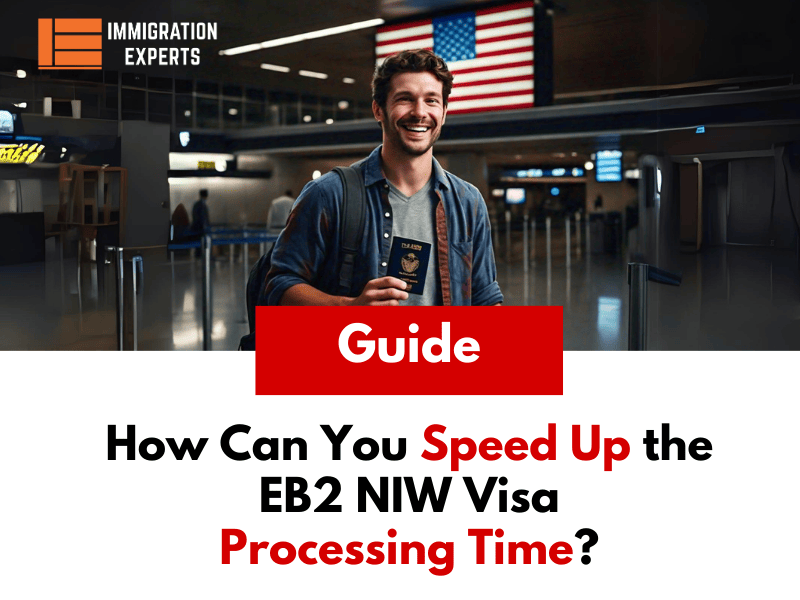051 8439995, 042 35911332

The EB2 NIW visa offers a pathway to securing a green card in the United States. In this guide, we will explore the typical duration for processing an EB2 visa and share tips on potentially expediting this process.
Generally, the timeline for processing an EB2 visa can average around 18 months from the initial application to completion. However, depending on the applicant’s country of origin, this timeframe might extend to several years in some instances.
Learn how you can speed up your EB2 NIW Visa processing time:
1. EB2 NIW Visa Processing Time (Step-by-Step)

The EB2 visa application process consists of three main stages. First, obtaining the PERM labor certification, second, filing the immigrant petition and finally completing the immigrant visa application or the adjustment of status. Typically, the whole process takes around 18 months, though in some situations, it might extend beyond this timeframe.
a. Perm Labor Certification
The initial phase of the EB2 visa application involves the PERM labor certification, which is handled by the U.S. employer in collaboration with the Department of Labor. This certification is crucial for proving that there are no available U.S. workers who are willing and able to fill the position, thus justifying the employment of a foreign national. It’s important to note that this step is not necessary for those applying under the EB2 national interest waiver category but is required for other EB2 visa applicants.
The PERM process includes obtaining a prevailing wage determination from the Department of Labor and carrying out a recruitment process to ensure no qualified U.S. workers are available for the job. Typically, it takes between 2 to 4 months to receive a prevailing wage determination, and the recruitment process must run for at least 60 days. While it is possible to initiate the recruitment process before receiving the prevailing wage determination, it’s wise to consult with an immigration attorney to assess whether this is advisable based on your specific circumstances.
It is important to submit the PERM labor certification application (Form ETA-9089) within 180 days of starting any recruitment efforts to avoid the expiration of these efforts. If you wait for the prevailing wage determination before beginning recruitment, the process could extend, potentially delaying the application.
Once the PERM application is submitted, the Department of Labor generally takes about 6 months to process the application. This period could be extended if the application is selected for an audit. Approval of this certification is essential before moving on to the next step of the EB2 visa process, which is filing the immigrant petition.
Therefore, the entire PERM labor certification process typically takes about 10 months to complete.
b. Immigrant Petition
The second step of the EB2 visa process involves filing the immigrant petition. This is typically done by the U.S. employer through the submission of Form I-140 to the United States Citizenship and Immigration Services (USCIS). However, individuals qualifying under the EB2 national interest waiver category have the option to self-petition.

For standard processing, the timeframe for USCIS to process the I-140 form is generally between 6 to 9 months. For those who need quicker results, there is an option for premium processing, which accelerates the processing time to approximately 15 days. It’s important to note, however, that premium processing is not available for those filing under the national interest waiver category.
c. Priority Date for EB2 NIW Visa
When you file your EB2 NIW visa immigrant petition (Form I-140), you will be assigned a priority date. This date is crucial as it determines when you can apply for your immigrant visa or proceed with the adjustment of status, which are the next steps in the immigration process.
The wait time associated with the priority date varies significantly based on your country of birth. Applicants from some countries may experience no delay and can immediately schedule their visa interview. However, for individuals from countries with higher demand for visas, such as China and India, the wait times can extend significantly, potentially for 10 years or more.
For current wait times and more detailed information, you can visit the USCIS visa bulletin website. Additionally, my team and I are available to provide you with an estimate of your expected wait time based on the latest information and trends.
d. Adjustment of Status
Once your priority date becomes current, as a foreign beneficiary, you have the option to apply for your immigrant visa at a U.S. embassy or consulate in your home country. Alternatively, if you are legally present in the United States, you may be eligible to apply for an adjustment of status domestically. It is crucial to initiate this process within one year of your priority date becoming current.
Before your interview, you must undergo a medical examination and gather all necessary documentation. If your application is approved by a U.S. consular officer or immigration officer, you will be granted EB2 visa status, allowing you to enter and reside in the United States with a green card.
The processing time for either applying for an immigrant visa or adjusting status is approximately 9 months on average.
Important Note: If your priority date is current and you are lawfully present in the U.S., you might be eligible to concurrently file your adjustment of status application (Form I-485) along with your immigrant petition (Form I-140). This concurrent filing can significantly expedite the overall processing time. We are here to assist you and determine if you are eligible for this streamlined approach.
To learn more about the EB2 NIW visa, click on the link.
2. PERM Audits
A common cause of delay in the EB2 visa application process is being subject to a PERM audit. These audits can be either targeted or random. Targeted audits are initiated when the Department of Labor identifies specific concerns with an application. Random audits, as the name suggests, can occur without any specific triggers.

Experiencing a PERM audit can extend the processing of your application by up to a year. Engaging an experienced immigration lawyer can be crucial in minimizing the risk of targeted audits and in efficiently managing any potential delays. It is also essential to maintain and organize all relevant documentation to smoothly handle a random audit should it occur.
Moreover, if USCIS has any concerns regarding the petition, they may issue a request for evidence (RFE), which can also cause further delays. Additionally, any inconsistencies, security concerns, or other issues that arise during the final consular interview may prolong the process by several months.
3. Priority Date Wait Times
A significant variable affecting the processing times of EB2 visas is the priority date system. Due to the limitations set by U.S. immigration law, only 28.6% of all employment-based green cards issued can be under the EB2 category. Furthermore, no more than 7% of the visas can be awarded to nationals from any single country. This cap often leads to longer wait times for applicants from countries with a high volume of applicants, as the demand exceeds the available supply, resulting in a waitlist. Nationals from countries like China and India, in particular, are likely to face extended wait times.
To get the most current information on wait times, you can visit the U.S. Citizenship and Immigration Services (USCIS) visa bulletin page.
4. Expediting the EB2 Process
There are several strategies to potentially accelerate the EB2 visa application process, depending on your eligibility and specific circumstances:
National Interest Waiver (NIW)
One effective way to expedite the EB2 process is by qualifying for a National Interest Waiver (NIW). If you qualify for this category, you can bypass the PERM labor certification step. This typically saves about 10 months of processing time. This exemption streamlines the process significantly.
It’s important to note, however, that premium processing is not available for NIW EB2 filings. If you do not qualify for an NIW, you will need to undergo the standard PERM labor certification process.
Premium Processing
For those not filing under the NIW, another option to expedite the EB2 visa process is through premium processing. This service enables you to receive a response on your EB2 immigrant petition within 15 days. It is a significant reduction from the usual processing time of 6-9 months. The current fee for premium processing is $1,440.
Limitations on Expediting
Unfortunately, it’s not possible to expedite your priority date. This means if you are from a country with high demand and associated visa backlogs, you must wait in line until your priority date becomes current.
Porting Your Priority Date
If you are from a country with prolonged wait times and qualify for an EB1 visa, you may consider porting your priority date. The EB1 category is a first-preference employment-based green card that generally has shorter wait times than the EB2. This could be a viable strategy to obtain your green card faster if you meet the EB1 eligibility criteria.
These options provide various pathways to potentially reduce the waiting period for your EB2 visa, depending on your specific situation and eligibility.
Final Thoughts
The EB2 NIW visa offers a valuable pathway to obtaining a U.S. green card, particularly for individuals with advanced degrees, exceptional abilities, or those whose work serves the national interest of the United States. To secure an EB2 visa, applicants must undergo several key steps. First, they must complete a PERM labor certification, unless they are exempt under the national interest waiver category. Next, they must file an immigrant petition. Finally, they apply for an immigrant visa or adjust their status within the U.S.
The overall process typically spans at least one year and often takes about 18 months. This duration starts from the beginning of PERM preparation and extends to the point of obtaining permanent resident status. However, the timeline can extend significantly depending on various factors.
With a clear understanding of EB2 visa processing times, you can better navigate the path toward U.S. permanent residency. Detailed knowledge of each stage, potential delays, expedited options, and factors affecting prolonged processing is essential. Whether you are applying conventionally or seeking ways to accelerate your application, the EB2 visa remains a robust option for those who meet the criteria.
